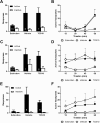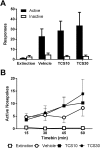The dual orexin receptor antagonist TCS1102 does not affect reinstatement of nicotine-seeking
- PMID: 28296947
- PMCID: PMC5351999
- DOI: 10.1371/journal.pone.0173967
The dual orexin receptor antagonist TCS1102 does not affect reinstatement of nicotine-seeking
Abstract
The orexin/hypocretin system is important for appetitive motivation towards multiple drugs of abuse, including nicotine. Both OX1 and OX2 receptors individually have been shown to influence nicotine self-administration and reinstatement. Due to the increasing clinical use of dual orexin receptor antagonists in the treatment of disorders such as insomnia, we examined whether a dual orexin receptor antagonist may also be effective in reducing nicotine seeking. We tested the effect of intracerebroventricular (i.c.v.) administration of the potent and selective dual orexin receptor antagonist TCS1102 on orexin-A-induced food self-administration, nicotine self-administration and reinstatement of nicotine-seeking in rats. Our results show that 30 μg of TCS1102 i.c.v. abolishes orexin-A-induced increases in food self-administration but does not reduce nicotine self-administration. Neither i.c.v. 10 μg nor 30 μg of TCS1102 reduced compound reinstatement after short-term (15 days) self-administration nicotine, but 30 μg transiently reduced cue/nicotine compound reinstatement after chronic self-administration (29 days). These results indicate that TCS1102 has no substantial effect on motivation for nicotine seeking following chronic self-administration and no effect after shorter periods of intake. Orexin receptor antagonists may therefore have little clinical utility against nicotine addiction.
Conflict of interest statement
Figures





Similar articles
-
Palatable food self-administration and reinstatement are not affected by dual orexin receptor antagonism.Prog Neuropsychopharmacol Biol Psychiatry. 2018 Dec 20;87(Pt A):147-157. doi: 10.1016/j.pnpbp.2017.06.028. Epub 2017 Jun 27. Prog Neuropsychopharmacol Biol Psychiatry. 2018. PMID: 28663114
-
Nucleus incertus Orexin2 receptors mediate alcohol seeking in rats.Neuropharmacology. 2016 Nov;110(Pt A):82-91. doi: 10.1016/j.neuropharm.2016.07.006. Epub 2016 Jul 7. Neuropharmacology. 2016. PMID: 27395787
-
Central orexin (hypocretin) 2 receptor antagonism reduces ethanol self-administration, but not cue-conditioned ethanol-seeking, in ethanol-preferring rats.Int J Neuropsychopharmacol. 2013 Oct;16(9):2067-79. doi: 10.1017/S1461145713000333. Epub 2013 Apr 22. Int J Neuropsychopharmacol. 2013. PMID: 23601187
-
Therapeutics development for addiction: Orexin-1 receptor antagonists.Brain Res. 2020 Mar 15;1731:145922. doi: 10.1016/j.brainres.2018.08.025. Epub 2018 Aug 24. Brain Res. 2020. PMID: 30148984 Free PMC article. Review.
-
Orexin Receptor Antagonists: Historical Perspectives and Future Opportunities.Curr Top Med Chem. 2016;16(29):3438-3469. doi: 10.2174/1568026616666150929111607. Curr Top Med Chem. 2016. PMID: 26416477 Review.
Cited by
-
Blockade of corticotropin-releasing factor-1 receptors in the infralimbic cortex prevents stress-induced reinstatement of alcohol seeking in male Wistar rats: Evidence of interaction between CRF1 and orexin receptor signaling.Neuropharmacology. 2022 Jun 1;210:109046. doi: 10.1016/j.neuropharm.2022.109046. Epub 2022 Mar 25. Neuropharmacology. 2022. PMID: 35341789 Free PMC article.
-
The Role of Orexin Receptor Antagonists in Inhibiting Drug Addiction: A Review Article.Addict Health. 2024 May;16(2):130-139. doi: 10.34172/ahj.2024.1491. Epub 2024 May 1. Addict Health. 2024. PMID: 39051042 Free PMC article. Review.
-
More than Smoke and Patches: The Quest for Pharmacotherapies to Treat Tobacco Use Disorder.Pharmacol Rev. 2020 Apr;72(2):527-557. doi: 10.1124/pr.119.018028. Pharmacol Rev. 2020. PMID: 32205338 Free PMC article. Review.
-
Suvorexant, an FDA-approved dual orexin receptor antagonist, reduces oxycodone self-administration and conditioned reinstatement in male and female rats.Front Pharmacol. 2023 Apr 27;14:1127735. doi: 10.3389/fphar.2023.1127735. eCollection 2023. Front Pharmacol. 2023. PMID: 37180716 Free PMC article.
-
Maternal exposure to Di-n-butyl phthalate (DBP) inhibit orexin receptor 1 (OX1R) expression to prevent Sertoli cells proliferation through the AKT signaling pathway.Toxicol Res (Camb). 2024 Sep 3;13(5):tfae140. doi: 10.1093/toxres/tfae140. eCollection 2024 Oct. Toxicol Res (Camb). 2024. PMID: 39238804
References
-
- Lim SS, Vos T, Flaxman AD, Danaei G, Shibuya K, Adair-Rohani H, et al. A comparative risk assessment of burden of disease and injury attributable to 67 risk factors and risk factor clusters in 21 regions, 1990–2010: a systematic analysis for the Global Burden of Disease Study 2010. The Lancet. 2012;380(9859):2224–60. - PMC - PubMed
MeSH terms
Substances
LinkOut - more resources
Full Text Sources
Other Literature Sources

